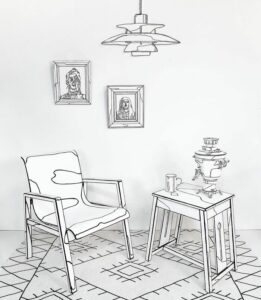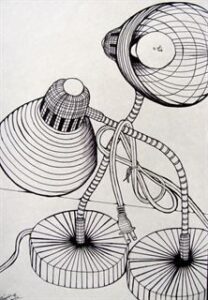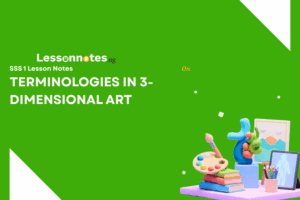Terminologies In 2 dimensional Art SS1 Visual Arts Lesson Note
Download Lesson Note
Lesson Notes
Topic: Terminologies In 2 dimensional Art

2-dimensional art, also known as 2D art, refers to artwork that has two dimensions: height and width. Unlike 3-dimensional art, which has depth (like sculptures), 2D art is flat and can be seen in forms such as drawings, paintings, and printmaking.
KEY TERMINOLOGIES IN 2-DIMENSIONAL ART
- Line: A line is a mark made by a tool such as a pencil or pen on a surface. It can be straight, curved, thick, or thin. Lines are important in creating shapes and patterns. They can be used to show movement and emotion in art.
- Shape: A shape is a closed space created by lines. Shapes can be geometric (like squares, triangles, and circles) or organic (natural, irregular shapes like the shape of a leaf or a cloud).
- Form: Although form is more commonly used in 3D art, it can also appear in 2D art when shading or perspective is used to give the illusion of depth or thickness.
- Color: Color refers to the hues we see in art. Colours can be primary (red, blue, yellow), secondary (colours created by mixing two primary colours like green, orange, and purple), or tertiary(mixing primary and secondary colours). Artists use colour to express feelings or highlight parts of their art.
- Texture: Texture is how something feels or looks like it would feel if touched. In 2D art, texture is implied (it gives the illusion of texture but remains smooth). Artists create texture by using different techniques to make a surface look rough, smooth, bumpy, etc.
- Value: Value refers to the lightness or darkness of a colour. By using different values, an artist can create depth and dimension, making objects look closer or farther away.
- Perspective: Perspective is a technique used to represent 3D objects on a 2D surface. It helps to create the illusion of depth, where objects closer appear larger, and those farther away appear smaller.
- Composition: Composition is how elements like lines, shapes, colours, and textures are arranged in an artwork. A good composition will guide the viewer’s eye through the artwork and create balance.
EXAMPLES OF 2D ART FORMS
- Drawing: Sketches or detailed pictures made with pencils, pens, or crayons on paper.
- Painting: Using watercolours, oil paints, or acrylics to create colourful pictures on surfaces like paper or canvas.
- Printmaking: Creating pictures by printing from a surface such as a woodblock or a metal plate.
- Collage: Artwork made by sticking various materials like paper, fabric, or photographs onto a surface.
ASSIGNMENT
- What is the difference between shape and form?
- Explain what texture means in 2D art.
- Give examples of primary and secondary colours.
- Why is perspective important in drawing?












